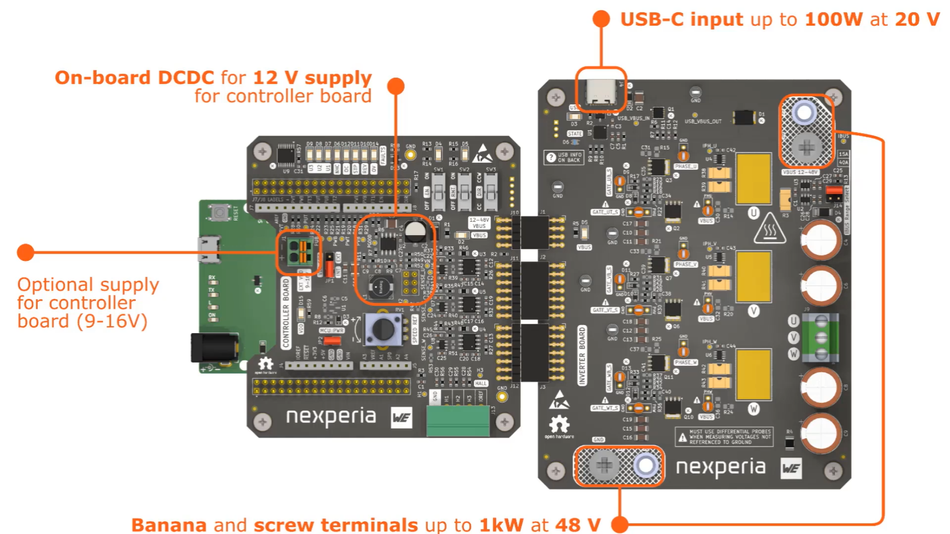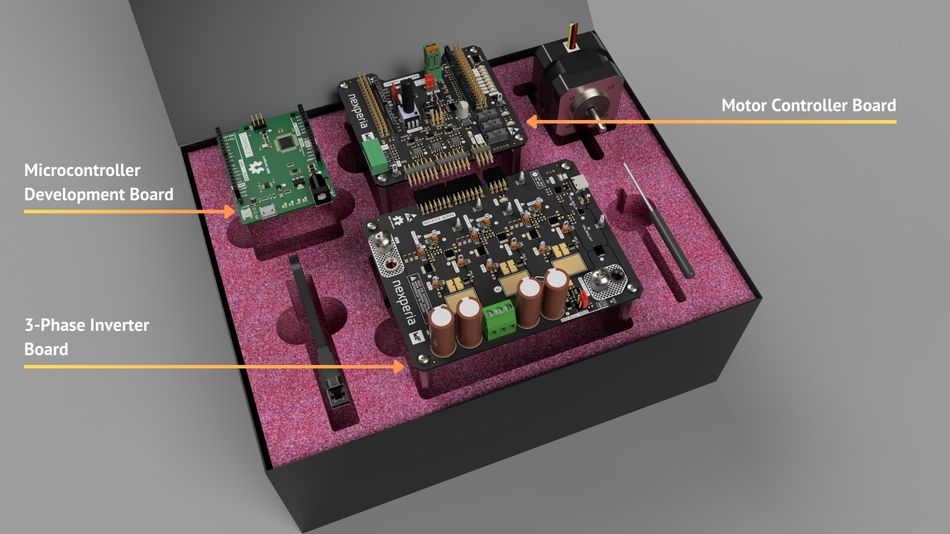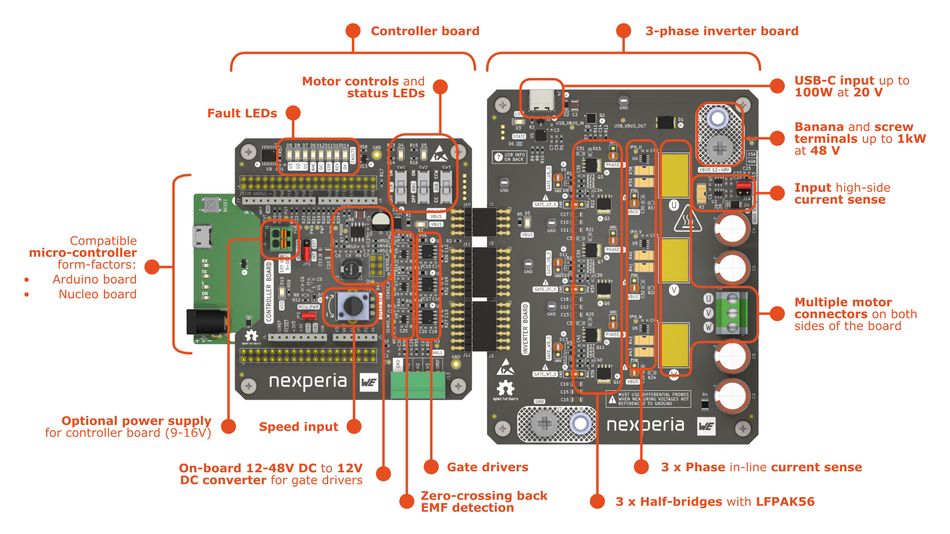Speeding Up Motor Drive Design, Testing, and Validation with Nexperia Motor Driver Evaluation Kit
Nexperia NEVB-MTR1-KIT1 is a motor driver evaluation kit that can be set up in under two minutes, supports USB-C Power Delivery, allows microcontroller and component swapping, and offers open-source firmware for fast customization and real-world motor control development.

Introduction
Motors are no longer passive elements in modern systems — they are precision-controlled actuators critical to the performance of electric vehicles, industrial automation, robotics, and high-efficiency appliances. As demands for dynamic response, fault tolerance, and energy optimization intensify, developing motor drives has become a multidimensional engineering challenge.
Hardware and software must converge seamlessly under increasingly compressed timelines. Engineers must design control loops that can adapt across operating conditions, ensure thermal and electrical stability at scale, and validate performance rapidly enough to keep projects moving forward. In this environment, tools that simply demonstrate basic motor operation are no longer sufficient. What’s needed is a platform that enables real-world validation, fast iteration, and hardware-software co-development from day one.
This article explores the critical challenges motor drive developers face today and introduces Nexperia’s NEVB-MTR1-KIT1 Motor Driver Evaluation kit — a modular, developer-centric platform built in collaboration with Würth Elektronik to accelerate motor control design, testing, and system integration.
Challenges in Designing and Testing Motor Drives
As motor-driven systems become more sophisticated and expectations for performance rise, engineers face a growing set of challenges that stretch beyond traditional motor control — challenges that now define the success or failure of modern designs, like:
Lengthy Setup Times
Setting up motor evaluation boards is often a major hurdle in itself. Before real testing even begins, engineers often spend four to six hours just setting up motor evaluation boards—connecting hardware, configuring parameters, and troubleshooting basic issues. This early-stage friction delays validation, slows iteration, and increases the chance of small setup mistakes snowballing into larger system problems later in development.
Selection of Power Electronic Components
Choosing the right switches (MOSFETs, IGBTs), gate drivers, and protection elements is critical for achieving desired efficiency, thermal performance, and reliability. Mismatched component ratings or poor driver-switch combinations can lead to excessive switching losses, thermal runaway, or degraded dynamic response. Engineers must carefully validate device behavior under real-world conditions, accounting for factors such as parasitics, switching transients, and EMI performance.
Sensor Integration and Calibration
Motor drives increasingly rely on precision sensing—whether through Hall-effect sensors, encoders, or sensorless algorithms—to deliver accurate position, speed, and current feedback. Misalignment, calibration drift, or signal noise can cause control inaccuracies, particularly in torque-intensive, low-speed, or dynamic operating conditions. Ensuring accurate, reliable sensor feedback is critical to achieving precise motor control and maintaining system stability.
Thermal Management Under Real-World Loads
Thermal management remains a major concern, especially as drives operate in compact enclosures with limited cooling resources. Engineers must rigorously validate how components such as MOSFETs, gate drivers, and current sensors handle peak loads, switching stresses, and environmental variations. Poor thermal design can lead to overheating, derating, reduced lifetime, or unexpected system shutdowns, making early thermal characterization essential.
Risk of Inadequate Early-Stage Validation
Skipping comprehensive validation during early development can have cascading effects: degraded motor efficiency, undetected fault conditions, and reliability failures in the field. These risks translate into higher project costs, missed deadlines, and potential damage to product reputation once deployed. Early validation is essential to catch performance gaps before they scale into critical system issues.
Hardware-Software Co-Development Complexity
Motor control development inherently blends physical hardware—MOSFETs, gate drivers, sensors—with embedded software, including control algorithms and real-time protection mechanisms. Aligning these layers introduces challenges in synchronization, tuning, and validation. Even small mismatches between software assumptions and hardware behavior can cause system instability, reduced efficiency, or reliability issues. Engineers must iteratively tune control parameters such as commutation timing, current loops, and protection thresholds while verifying real-world performance across varying load conditions.
Debugging, Iteration Overhead, and Testing Challenges
Troubleshooting motor drives is time-intensive, particularly when development environments lack standardization, isolation, or repeatability. Without standardized test platforms, diagnosing whether a bottleneck stems from hardware, firmware, sensing inaccuracies, or system integration becomes a slow, trial-and-error process.
There is an increasing need for isolated, repeatable testing environments—especially to validate current sensing accuracy, timing coordination, and fault response reliability. Without these, even minor issues can escalate into significant project delays and compromised system performance.
Adaptability Across Different Motor and Control Requirements
Modern projects often require supporting multiple motor types, control methods, or load conditions within the same product family. Without flexible evaluation setups, adapting designs from one configuration to another demands extensive hardware and software rework. Lack of early-stage adaptability can severely limit design reuse, slow down feature expansion, and increase development costs.
Introducing NEVB-MTR1-KIT1 Motor Evaluation Kit by Nexperia and Würth Elektronik
To address the persistent challenges in motor drive development, Nexperia, in collaboration with Würth Elektronik, has introduced the NEVB-MTR1-KIT1 Motor Driver Evaluation Kit — a modular, high-performance platform built to simplify design, accelerate validation, and empower innovation. Leveraging Würth Elektronik’s proven expertise in passive components, EMC design, and connectivity solutions, the platform ensures not only flexibility and modularity but also robust real-world performance that engineers can rely on from the very first spin-up.
Unlike many evaluation boards designed around specific microcontrollers, the NEVB-MTR1-KIT1 centers on flexibility at the hardware level. It enables engineers to evaluate discrete components like MOSFETs, gate drivers, and sensors independently, making it a true building block for modern motor drive development rather than a fixed, narrowly scoped kit.
Key Components:
MOSFET Power Stage: Equipped with three LFPAK56 half-bridges (using PSMN3R9-100YSF MOSFETs) to deliver compact, thermally optimized, and rugged high-current switching performance.
Gate Driver Integration: Utilizes the NGD4300D gate driver for efficient and robust high-side and low-side switching, supporting fast and reliable commutation under demanding load conditions.

Sensor Feedback Interfaces: Provides direct hardware compatibility for Hall sensors, incremental encoders, absolute encoders, or any position sensors that can communicate using SPI and enables back-EMF zero-crossing detection for sensorless control without requiring additional interface circuits.
Speed Control Support: Offers options for both hardware-based and remote control of motor speed, supporting both open-loop and closed-loop control methods.Fault Monitoring and Status LEDs: Onboard LEDs provide real-time visual feedback on system faults and motor operating status, supporting quick diagnostic testing.
Core Capabilities:
Quick Motor Bring-Up: Unlike traditional evaluation boards that require four to six hours for hardware wiring, firmware flashing, sensor alignment, and initial motor tuning, the NEVB-MTR1-KIT1 enables complete setup and first motor spin-up in under two minutes. Pre-validated hardware configurations, default firmware support, and standardized connector mappings eliminate common setup bottlenecks, allowing engineers to transition immediately from hardware initialization to system-level testing.
Modular Two-Board Architecture: The NEVB-MTR1-KIT1 is organized into a modular system combining a Controller Board and a 3-Phase Inverter Board, cleanly separating control and power stages for easier development and testing.
Flexible Power Input Options: Supports multiple input sources, including USB-C input (up to 100W at 20V) for portable setups and high-power banana or screw terminals (up to 1kW at 48V) for demanding motor drive evaluations.
Microcontroller Interface Support: Compatible with Arduino Leonardo R3 and Nucleo form factors, offering standardized pinouts while remaining adaptable for custom microcontroller platforms.
- Wide Motor Support: Designed to drive a range of motors — BLDC, PMSM, and Brushed DC motors — the board offers engineers the freedom to experiment across applications without needing separate setups.
Flexible Control Methods: It supports various motor control strategies such as trapezoidal drive, sinusoidal control, and FOC. Sensor-based (Hall-effect, incremental encoders, absolute encoders) and sensorless operation (back-EMF zero-crossing detection) are both possible without significant hardware modifications.
Integrated Current Sensing and Fault Monitoring: The board incorporates built-in high-side input current sensing and three-phase in-line current sensing for accurate real-time monitoring, along with onboard fault LEDs and motor control/status indicators to provide immediate visual feedback during development and debugging—eliminating the need for additional external instrumentation.
Open Hardware Architecture: Engineers are not locked into any specific microcontroller. The board is compatible with Arduino Leonardo R3 and Nucleo form factors, but can also be adapted for custom controllers. Users can swap microcontrollers, modify firmware, or integrate their own embedded systems easily.
USB Power Delivery (PD) Support: Recognizing practical lab needs, Nexperia designed the board to be powered not just by traditional bench supplies, but also via USB PD chargers (like laptop adapters). This removes a key barrier to quick testing, allowing faster initial bring-up without specialized equipment.
DC-DC Converter Integration: The board features an integrated DC-DC converter that steps down voltages internally to supply control electronics, sensors, and auxiliary circuits from a single input source. This eliminates the need for multiple external supplies for logic, gate drive, and control, significantly simplifying wiring, reducing system complexity, and enabling true single-supply operation.
Optimized for Real-World Testing: The NEVB-MTR1-KIT1 includes modular connections, high-current rated components, and thermal design considerations that allow engineers to evaluate systems realistically under various load and fault conditions.
Documented and Hackable: Extensive documentation, open-source firmware, and modular hardware design encourage developers to "hack" the board — replacing MOSFETs, adjusting gate driver configurations, experimenting with different sensors, or even changing motor types — without needing to redesign or fabricate new PCBs.
With the NEVB-MTR1-KIT1, Nexperia shifts the evaluation board paradigm — Instead of forcing engineers into a fixed "reference" design, the board becomes a modular, developer-friendly platform adaptable to a wide variety of motors, control algorithms, and experimental setups. This flexibility not only accelerates motor control design but also enables faster iteration, testing, and optimization — exactly what modern engineering projects demand.
For more details, visit https://www.nexperia.com/applications/evaluation-boards/nevb-mtr1-kit1
Conclusion
Accelerating motor drive design requires tools that simplify complexity without limiting flexibility. Nexperia’s NEVB-MTR1-KIT1 Motor Driver Evaluation kit delivers exactly that — offering a modular, adaptable platform that supports a wide range of motors, control strategies, and hardware configurations.
By enabling rapid prototyping, easy customization, and realistic real-world validation, the board streamlines every phase of development. Features like USB PD support, open-source firmware, modular component architecture, and robust thermal design help engineers move faster from concept to product.
In an industry where speed, reliability, and innovation are critical, platforms like the NEVB-MTR1-KIT1 don't just assist development — they fundamentally reshape it. With this evaluation board, Nexperia empowers engineers to build better motor control solutions — faster, smarter, and with greater confidence.
References
[1] Nexperia. NEVB-MTR1-KIT1 Motor Evaluation Board [Internet]. Available from: https://www.nexperia.com/applications/evaluation-boards/nevb-mtr1-kit1
[2] Nexperia. UM90029 – NEVB-MTR1-KIT1 User Manual [Internet]. Available from: https://assets.nexperia.com/documents/user-manual/UM90029.pdf
[3] Würth Elektronik. LFPAK56 NEVB-MCTRL-100-BLDC-Buck Reference Design [Internet]. Available from: https://www.we-online.com/en/components/icref/nexperia/LFPAK56-NEVB-MCTRL-100-BLDC-Buck




